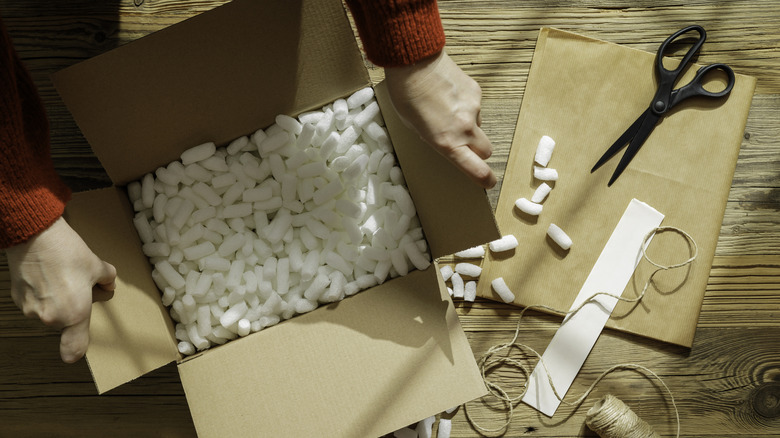This DIY Transforms Styrofoam Into Homemade Glue, But Is It Safe?
We may receive a commission on purchases made from links.
Turning Styrofoam into homemade glue sounds a bit like a mad-scientist hack. It's real, and it's simple to do, but is it actually safe? The hack requires that you use some acetone to break down the Styrofoam and create a sticky paste you can use as glue. But before you run to the garage and start on a batch of homemade glue, you should consider some of the risks associated with this DIY.
To make DIY Styrofoam glue, fill a small jar or can with a quarter or half a cup of acetone. Commercial or industrial acetone is best for this hack, but you can also use some nail polish remover from your bathroom cabinet, as long as it's 100 percent acetone. Then, break down small bits of Styrofoam and sprinkle them into the acetone, mixing with a plastic spoon or wood stirrer as you go. After a couple of minutes of stirring, the Styrofoam should melt into a sticky, almost slimy paste at the bottom of the jar. With a plastic spoon, you can grab some of that paste and use it as glue.
To fully understand how this works, you'll have to go back into your chemistry textbooks. In simple terms, a chemical reaction causes the acetone to break down the styrofoam's structure, and the air that fills it and makes it foam gets pushed out. By losing its airy texture, the Styrofoam turns into a sticky paste. However, acetone is a tricky chemical to work with at home. So, if after reading this article you decide not to attempt it, there are other genius ways to reuse packing Styrofoam at home to try instead.
The downsides of DIY Styrofoam glue
So, this hack seems like a great DIY way to repurpose Styrofoam in your home, right? Well, working with acetone at home has some downsides. First of all, it's a very flammable substance. Anything made with acetone, even in little amounts, can catch fire easily. By using an acetone-based glue, you're turning your DIY projects and scrapbooks into a fire hazard. In addition, acetone is a substance with a strong odor that creates toxic fumes, and these can be even more harmful when combined with Styrofoam. Working with acetone indoors can cause headaches and nausea, among other health complications. To avoid inhaling fumes and getting sick, DIY glue has to be made outside with proper equipment like gloves and masks. On top of being dangerous, acetone is expensive. A bottle of Alliance Chemical 100 Percent Pure Acetone costs as much as $29.99. At that rate, you'd likely be better off buying a bottle of glue.
If you'd like to give this hack a try, there are some safer alternatives to acetone that you can consider. For example, some people have tested using pure orange oil instead. This seems to work as long as you're using 100 percent pure orange oil without any other oils and additives. Again, this might be a fun DIY, but it won't necessarily be cheaper than buying glue, since a small bottle of Plant Therapy Pure Orange Essential Oil costs nearly $15.99. There are also other recipes you can follow to make strong, nontoxic craft glue with common kitchen ingredients.
